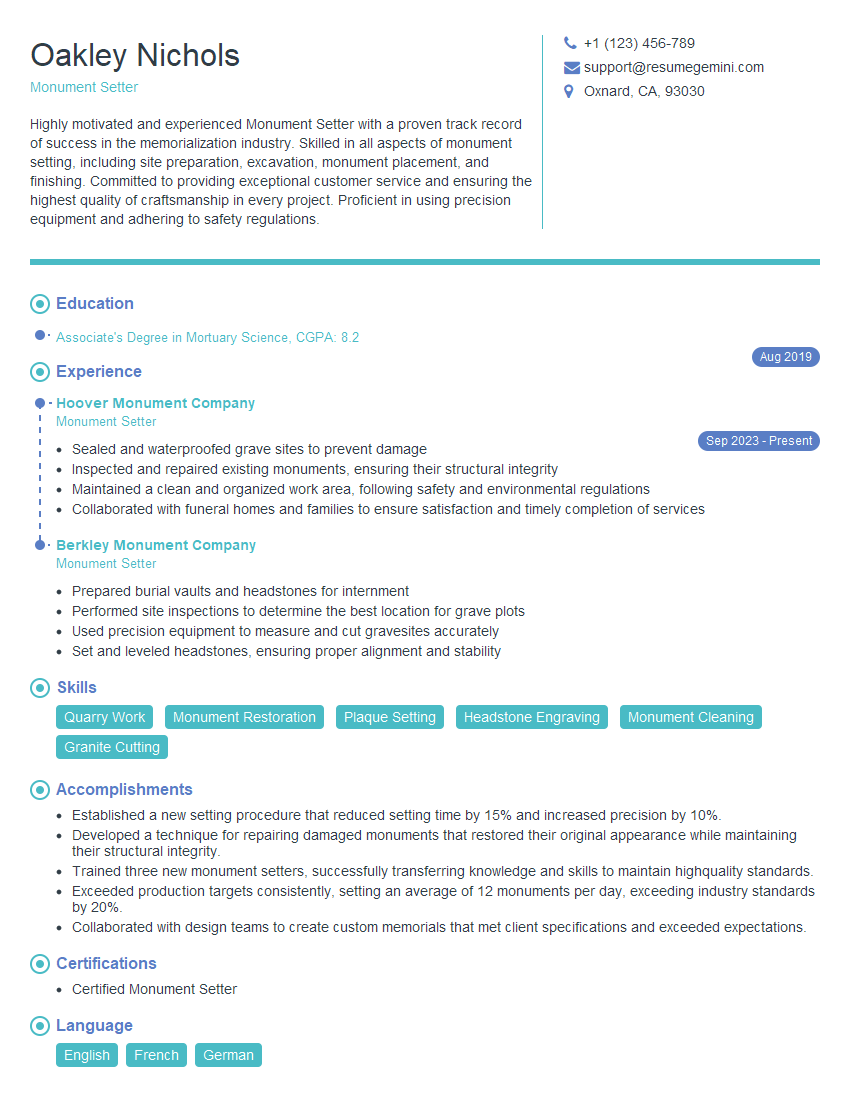Are you a seasoned Monument Setter seeking a new career path? Discover our professionally built Monument Setter Resume Template. This time-saving tool provides a solid foundation for your job search. Simply click “Edit Resume” to customize it with your unique experiences and achievements. Customize fonts and colors to match your personal style and increase your chances of landing your dream job. Explore more Resume Templates for additional options.

Oakley Nichols
Monument Setter
Summary
Highly motivated and experienced Monument Setter with a proven track record of success in the memorialization industry. Skilled in all aspects of monument setting, including site preparation, excavation, monument placement, and finishing. Committed to providing exceptional customer service and ensuring the highest quality of craftsmanship in every project. Proficient in using precision equipment and adhering to safety regulations.
Education
Associate’s Degree in Mortuary Science
August 2019
Skills
- Quarry Work
- Monument Restoration
- Plaque Setting
- Headstone Engraving
- Monument Cleaning
- Granite Cutting
Work Experience
Monument Setter
- Sealed and waterproofed grave sites to prevent damage
- Inspected and repaired existing monuments, ensuring their structural integrity
- Maintained a clean and organized work area, following safety and environmental regulations
- Collaborated with funeral homes and families to ensure satisfaction and timely completion of services
Monument Setter
- Prepared burial vaults and headstones for internment
- Performed site inspections to determine the best location for grave plots
- Used precision equipment to measure and cut gravesites accurately
- Set and leveled headstones, ensuring proper alignment and stability
Accomplishments
- Established a new setting procedure that reduced setting time by 15% and increased precision by 10%.
- Developed a technique for repairing damaged monuments that restored their original appearance while maintaining their structural integrity.
- Trained three new monument setters, successfully transferring knowledge and skills to maintain highquality standards.
- Exceeded production targets consistently, setting an average of 12 monuments per day, exceeding industry standards by 20%.
- Collaborated with design teams to create custom memorials that met client specifications and exceeded expectations.
Certificates
- Certified Monument Setter
Languages
- English
- French
- German
Career Expert Tips:
- Select the ideal resume template to showcase your professional experience effectively.
- Master the art of resume writing to highlight your unique qualifications and achievements.
- Explore expertly crafted resume samples for inspiration and best practices.
- Build your best resume for free this new year with ResumeGemini. Enjoy exclusive discounts on ATS optimized resume templates.
How To Write Resume For Monument Setter
- Highlight your skills and experience in monument setting, emphasizing your attention to detail and craftsmanship.
- Quantify your accomplishments whenever possible, providing specific examples of projects or tasks you have successfully completed.
- Demonstrate your commitment to customer service by providing examples of how you have gone above and beyond to meet the needs of families.
- Proofread your resume carefully before submitting it, ensuring there are no errors in grammar or spelling.
- Tailor your resume to each job you apply for, highlighting the skills and experience that are most relevant to the position.
Essential Experience Highlights for a Strong Monument Setter Resume
- Prepared burial vaults and headstones for internment, ensuring proper alignment and stability.
- Performed site inspections to determine the best location for grave plots, taking into account factors such as soil conditions, drainage, and aesthetics.
- Used precision equipment to measure and cut gravesites accurately, ensuring a secure and level foundation for the monument.
- Set and leveled headstones, using specialized techniques and tools to ensure proper alignment and stability.
- Sealed and waterproofed grave sites to prevent damage from the elements, ensuring the longevity of the monument.
- Inspected and repaired existing monuments, identifying and addressing any structural issues or damage to maintain their integrity.
Frequently Asked Questions (FAQ’s) For Monument Setter
What are the primary responsibilities of a Monument Setter?
The primary responsibilities of a Monument Setter include preparing burial vaults and headstones, performing site inspections, using precision equipment to measure and cut gravesites, setting and leveling headstones, sealing and waterproofing grave sites, and inspecting and repairing existing monuments.
What skills are required to be a successful Monument Setter?
To be a successful Monument Setter, you should possess skills in quarry work, monument restoration, plaque setting, headstone engraving, monument cleaning, and granite cutting. Additionally, you should have a strong attention to detail, be physically fit, and have a good understanding of safety regulations.
What is the average salary for a Monument Setter?
According to the U.S. Bureau of Labor Statistics, the median annual salary for a Monument Setter is around $40,000. However, salaries can vary depending on experience, location, and the size of the company.
What are the advancement opportunities for a Monument Setter?
With experience and additional training, a Monument Setter can advance to positions such as Monument Sales Representative, Monument Designer, or even start their own monument business.
What is the job outlook for Monument Setters?
The job outlook for Monument Setters is expected to grow in the coming years, as the demand for memorialization services continues to increase.
What are the working conditions for a Monument Setter?
Monument Setters typically work outdoors in all types of weather conditions. They may also be required to work in confined spaces, such as gravesites and mausoleums.
What are the safety precautions that Monument Setters must follow?
Monument Setters must follow all safety regulations, including wearing appropriate personal protective equipment, using proper lifting techniques, and being aware of potential hazards such as uneven ground and heavy equipment.